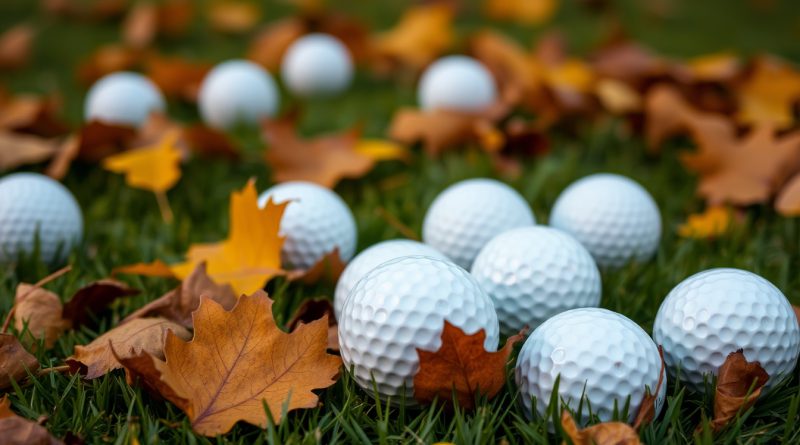Golf Balls for Cooler Weather: Which Ones Perform Best in Cooler Weather?
The quick transition from the warmth of summer to the chill of fall raises an important question: are we really prepared for the changes it brings to our golf game? While many golfers are distracted by the beauty of autumn, the cooler weather can dramatically influence how we play, particularly when it comes to our choice of golf balls for cooler weather.
How can we adjust our equipment to meet the demands of the season? We’ll explore how cooler temperatures influence golf ball performance and recommend the best options to enhance your game this autumn.
Article Quick Look:
- The transition to fall brings challenges for golfers, particularly regarding their choice of golf balls for cooler weather.
- Cooler temperatures can affect golf ball performance, reducing distance and altering feel due to increased air density.
- Choosing the right golf balls involves considering factors like durability, compression, and temperature sensitivity to maintain optimal performance.
- Recommended golf balls for fall conditions include models like the Titleist Pro V1, Callaway Chrome Soft, and TaylorMade TP5, which excel in cooler weather.
How Does Cooler Weather Affect Your Golf Ball Performance?
As temperatures drop in the fall, the density of the air increases, which can hinder the distance a golf ball travels. Cooler weather affects how golf balls for cooler weather compress, often resulting in reduced launch and, consequently, less distance.
The denser air creates more drag on the ball, causing it to fall short of your expectations. Additionally, the feel of a golf ball becomes paramount, especially when precision is key. In cooler temperatures, the ball can feel firmer upon impact, which may not be ideal for every golfer. Many players prefer a softer touch around the greens, where feel and control are essential for effective chipping and putting.

Characteristics of Golf Balls for Cooler Weather
- Durability: As temperatures drop, durability becomes even more critical. Golf balls designed to withstand cooler conditions are typically made from advanced materials that resist cracking and maintain their structural integrity. A durable ball ensures that it can handle the rigors of fall golf, such as harder ground conditions and varying weather elements like dew or light rain. Many premium balls feature a tough outer cover, often made of urethane or a durable ionomer blend, which enhances durability without sacrificing feel.
- Compression: Lower-compression golf balls are generally more suitable for cooler weather. These balls are engineered to compress effectively even at lower temperatures, helping them achieve optimal distance and feel. A lower compression rating (below 80) improves energy transfer from the clubface, leading to greater distance. Additionally, these balls tend to provide a softer feel, making them more forgiving on mishits. When selecting a golf ball, look for those with multi-layer designs that combine a softer inner core with a firmer outer layer. This construction allows for improved performance in cooler conditions, giving you a better response and touch when approaching the greens.
- Temperature Sensitivity: It’s essential to consider how specific golf balls respond to varying temperatures. Some balls are specifically designed to perform well across a wide range of temperatures, making them versatile options for fall golf. Look for products that advertise “temperature-responsive” technology, which adjusts the ball’s compression and feel according to the ambient temperature. These innovations can help maintain performance consistency and give golfers the confidence they need during fluctuating conditions.
- Flight Path: The flight path of a golf ball can also be affected by cooler temperatures. Higher launching balls might struggle to achieve the desired height and distance due to the increased drag from denser air. Therefore, choosing a ball that provides a stable and penetrating flight can be beneficial. Balls designed with aerodynamic features, such as optimized dimple patterns, can help reduce drag and enhance lift, ensuring your shots travel farther despite the cooler conditions.
Related Reads:
- Impact of Altitude on Golf Ball Performance: Tips for High Elevation Play
- DIY Golf Ball Testing: How to Evaluate Performance on the Course
- Best Golf Balls for Beginners: Expert Recommendations and Player Reviews
The Best Golf Balls for Fall Conditions
When it comes to selecting the right golf balls for cooler weather, it’s essential to choose models that excel in cooler conditions. The following golf balls have been carefully selected based on their performance characteristics, durability, and ability to maintain feel and distance in lower temperatures.
Titleist Pro V1
The Titleist Pro V1 consistently impresses golfers with its outstanding performance. In cooler weather, it delivers a perfect balance of distance, feel, and control. Its advanced core design helps maintain optimal performance in lower temperatures, ensuring you can still achieve impressive distance while enjoying a soft feel around the greens.
Callaway Chrome Soft
The Callaway Chrome Soft is another excellent option for cooler weather. With its low compression and soft feel, this ball provides outstanding distance without sacrificing control. The dual-core construction allows it to perform well in various conditions, making it a favorite among golfers looking for reliability in the fall.

TaylorMade TP5
The TaylorMade TP5 features a multi-layer design that offers versatility and performance. Its five-layer construction enhances control and distance, ensuring that you can maximize your game even as temperatures drop. The TP5’s soft feel helps maintain responsiveness, making it ideal for those delicate shots around the green.

Srixon Z-Star
The Srixon Z-Star is a standout option for durability and feel in cooler conditions. Its advanced construction allows it to maintain performance, while the soft cover provides excellent feedback. Golfers appreciate its control on approach shots and its ability to perform consistently in changing weather conditions.
Bridgestone Tour B RX
For golfers seeking a lower compression option, the Bridgestone Tour B RX is an excellent choice. Its design caters to players looking for a blend of distance and control in cooler temperatures. This ball helps achieve longer drives and provides a softer feel, ensuring you have the performance needed for a successful fall round.
More Related Articles:
- The Best Golf Balls for Seniors: Enhance Your Game in 2024
- Golf Ball Pack Size: How to Choose the Right One
- Supercharge Your Game: How to Choose the Right Golf Ball for Different Courses
Tips for Playing in Cooler Weather
Adjust Your Game Strategy:
- Use a slower swing speed to accommodate the firmer feel of the ball.
- Focus on making solid contact with the ball to maximize distance and accuracy.
- Consider using a more club than usual, as cooler temperatures can affect distance.
Golf Ball Care in Cooler Weather:
- Keep your golf balls warm before play by storing them in a warm place, like your car.
- Avoid leaving balls exposed to cold temperatures for extended periods.
- Use a golf ball warmer or pocket warmer to keep them at optimal temperature before
Check Course Conditions:
- Be mindful of wet or slippery conditions on the course, which can affect playability.
- Adjust your shot strategy based on how the cooler weather affects the course conditions.your round.
Main Takeaway
As the season shifts from summer to fall, it’s essential to adapt your golf game to the cooler temperatures. Understanding how cooler weather affects performance is essential, but so is embracing the season’s changes.
By choosing the right golf balls and adjusting your strategies, you can turn the challenges of fall golf into an enjoyable and rewarding experience. So grab your favorite ball and step onto the course, ready to make the most of this vibrant season.
Before You Go!
- Best Golf Balls to Buy in 2024
- Navigating the Golf Ball Rollback: Implications and Insights
- Integrating Technology in Golf: Revolutionizing the Game with Advanced Golf Balls and Simulators
Writer/Editor: Danny Kapp is a passionate golf enthusiast and an 9-year veteran golf blog writer for Rock Bottom Golf, offering his unique perspective on the game. With a keen eye for detail, he covers various aspects of golf, ranging from technical insights to the latest trends in golf equipment and golf technology.








Pingback: Winter Golf Travel Essentials: Best Bags & Gear for Holiday Trips